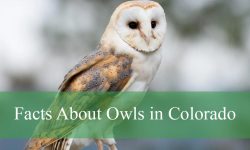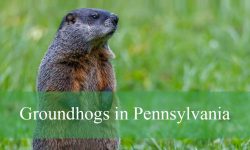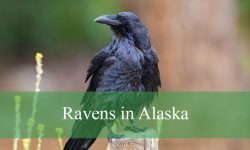Woodpeckers in Florida are a remarkable feature of the state’s natural landscape, offering both beauty and ecological benefits. The array of woodpeckers in Florida, from the strikingly patterned Northern Flicker to the distinctive Red-Bellied Woodpecker, enriches the local wildlife scene.
These birds are essential for their roles in controlling insect populations and creating nesting opportunities for other species.
The following article will explore 12 common woodpecker species found in Florida and how to identify them.
Different Types of Woodpeckers in Florida
Downy Woodpecker
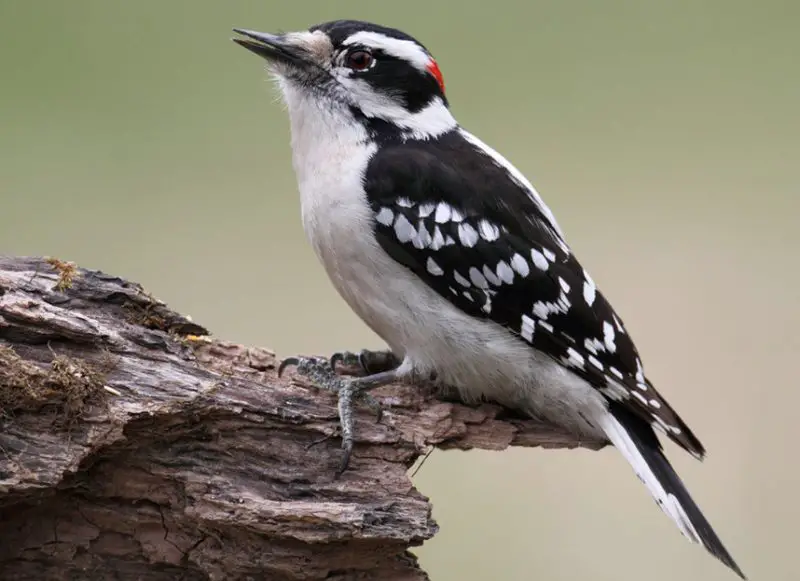
The Downy Woodpecker (Dryobates pubescens) is the smallest woodpecker in North America, easily recognized by its black-and-white plumage and compact size. One of its standout characteristics is its drumming behavior, which serves multiple purposes such as attracting mates, marking territory, or communicating with other birds. These woodpeckers can drum at speeds of up to 20 beats per second, and the frequency of drumming may vary depending on the type of tree or surface they are striking.
Unlike larger woodpeckers, the Downy Woodpecker is not considered a threat to homes or structures. It rarely causes property damage and is a common visitor to backyard bird feeders, where it enjoys suet cakes and sunflower seeds.
These adaptable birds can thrive in a variety of habitats, from open deciduous-coniferous forests to residential neighborhoods and urban parks. Their diet includes insects, seeds, suet, and fruits, making them well-suited to survive in diverse regions. Due to their small size and friendly presence, Downy Woodpeckers are often a welcomed sight in many backyards across North America.
Hairy Woodpecker
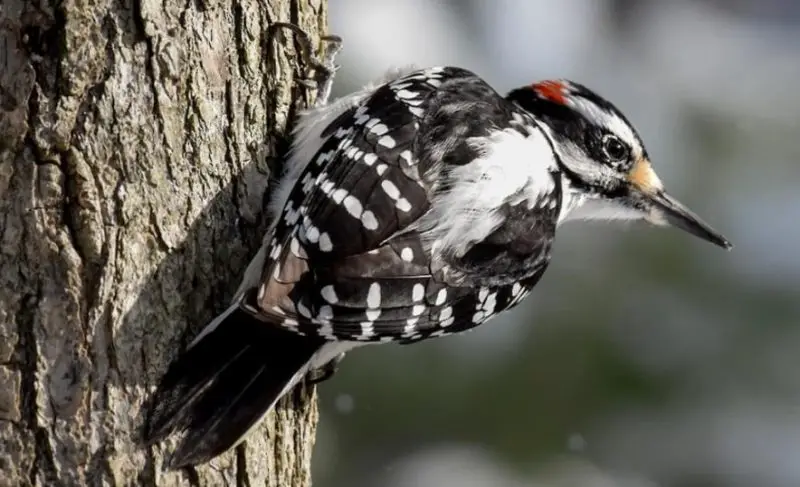
The Hairy Woodpecker (Leuconotopicus villosus) is a medium-sized bird, easily identified by its striking black-and-white plumage. Males are distinguished by a small red patch on the back of their head, while females lack this feature. Both sexes share similar patterns, making them visually striking in the wild.
Equipped with a sharp, chisel-like beak and sturdy legs, the Hairy Woodpecker is an expert at pecking and climbing tree trunks. Its strong claws help it grip bark as it forages for food. One of its most remarkable traits is its acute sense of hearing, allowing it to detect insects hiding beneath tree bark. This bird plays a crucial role in controlling pest populations, particularly wood-boring insects like the destructive Emerald Ash Borer.
Hairy Woodpeckers are also known for their drumming, a behavior used to establish territory, attract mates, and communicate with other woodpeckers. Their drumming, combined with their ability to detect and consume pests, makes them an essential part of many forest ecosystems across North America.
Yellow-Bellied Sapsucker
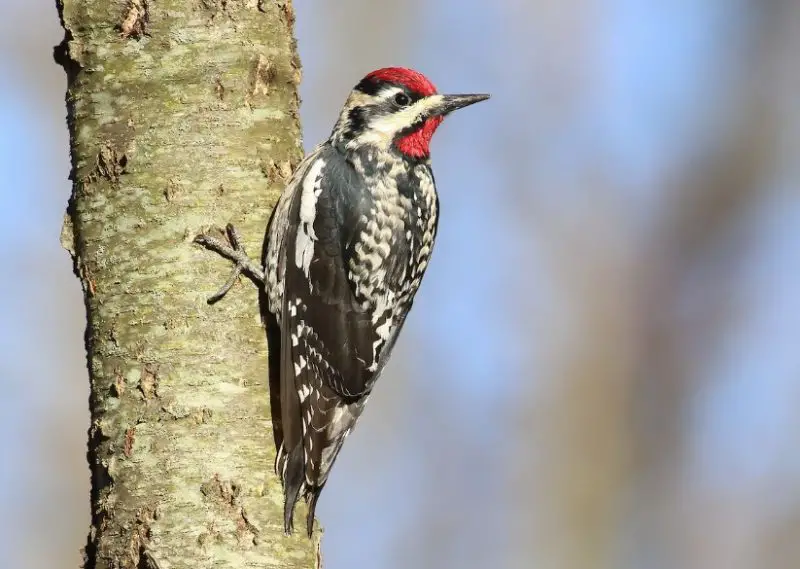
The Yellow-Bellied Sapsucker (Sphyrapicus varius) is a medium-sized woodpecker known for its striking black-and-white pattern, accented by its olive-yellow breast and belly. Adult males of the species are easily identified by a vivid red patch on both their forehead and throat, while females have the red coloration only on their forehead. These unique colorations make them stand out in their forest habitats.
Newly hatched Yellow-Bellied Sapsuckers are blind and vulnerable, relying heavily on both parents for nourishment and protection. Both male and female sapsuckers take turns feeding and caring for their young, which are ready to leave the nest and fly on their own around 25 to 30 days after hatching.
This species plays a vital role in maintaining forest ecosystems, acting as pollinators and aiding in seed dispersal for various trees, flowers, and shrubs. They are considered a keystone species due to their significant impact on biodiversity. Yellow-Bellied Sapsuckers primarily feed on tree sap and insects, but their diet expands to include fruits and berries in the summer, providing necessary nutrition during the breeding season. Their unique feeding habits and ecological contributions make them essential to forest health and diversity.
Williamson’s Sapsucker

Williamson’s Sapsucker (Sphyrapicus thyroideus) is a fascinating woodpecker species known for its unique feeding habits. These birds create small holes called sap wells in the bark of trees like pines, firs, and aspens to release sap, which attracts insects. Using their long, specialized tongues, Williamson’s Sapsuckers skillfully feed on both the sap and the insects trapped within it.
These birds also play a critical role in their ecosystems by excavating nesting cavities in trees. After they finish using these cavities, other bird species like nuthatches, chickadees, and bluebirds take over, making Williamson’s Sapsucker an important contributor to the overall health and diversity of woodland communities.
Unlike many other woodpecker species, Williamson’s Sapsuckers do not use their drumming to find insects beneath tree bark. Instead, their drumming is primarily associated with courtship rituals and territorial displays. This behavior further distinguishes them from other woodpeckers, adding to their uniqueness in the bird world.
Red-Bellied Woodpecker
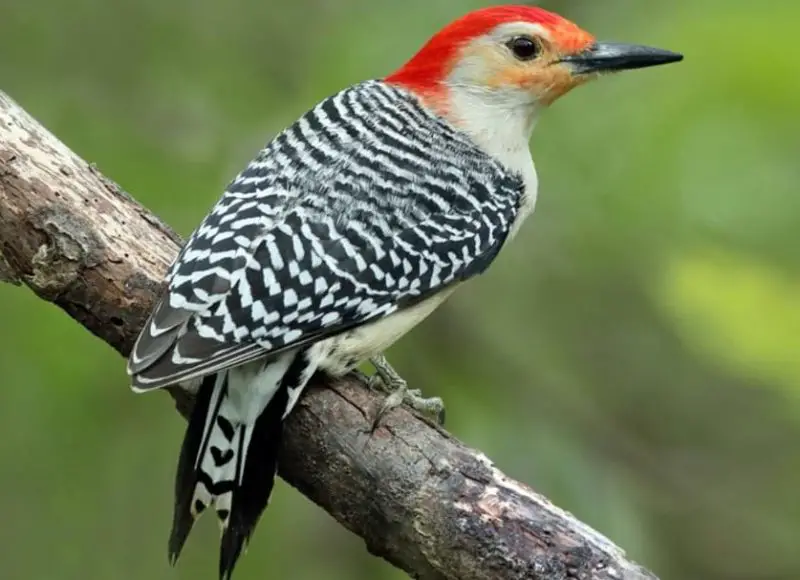
The Red-Bellied Woodpecker (Melanerpes carolinus) is a medium-sized bird known for its striking black and white barred back and a distinctive red cap. Males feature a red crown that stretches from the bill to the neck, while females have red only on the back of their neck. Despite its name, the red coloring on its belly is often faint and not easily visible, making the bird’s head the more prominent identifying feature.
These woodpeckers are often seen clinging to tree trunks and branches, where they forage for insects, nuts, and fruit. One interesting behavior is their tendency for “kleptoparasitism,” where they steal food from other birds, sometimes even snatching it directly from another bird’s beak.
In terms of sound, the Red-Bellied Woodpecker is quite vocal, producing loud, rolling calls and frequently drumming on trees as part of communication and territory marking. This species is commonly found in forests, woodlands, and urban areas across the eastern United States, easily recognized by their bold patterns and distinctive sounds.
Red-Headed Woodpecker
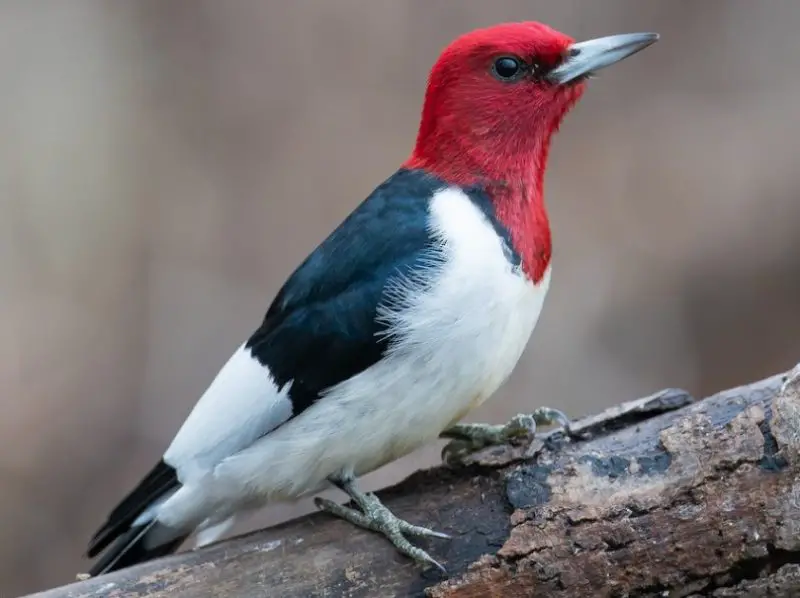
The Red-Headed Woodpecker (Melanerpes erthrocephalus) is a striking bird species, easily identified by its vibrant redhead and bold black-and-white body, giving it the nickname “flying checkerboard.” Both males and females share the same eye-catching plumage, with the red head being its most distinctive feature.
These woodpeckers are known for their territorial nature, often aggressively defending their territory, including bird feeders, from other birds—even larger woodpecker species. Another interesting characteristic of the Red-Headed Woodpecker is its hoarding behavior. It caches food, such as insects and nuts, in tree cavities, a strategy that helps it survive during the winter months.
Vocalization is another key trait of the Red-Headed Woodpecker. Instead of relying solely on drumming like many other woodpeckers, it produces a raspy “churr” call that is often heard in its habitat.
Unfortunately, despite its adaptability, the species has experienced population decline due to habitat loss and environmental changes. As a result, it is now classified as “Near Threatened” on the IUCN Red List, highlighting the need for conservation efforts to protect its natural habitats.
Red-Cockaded Woodpecker
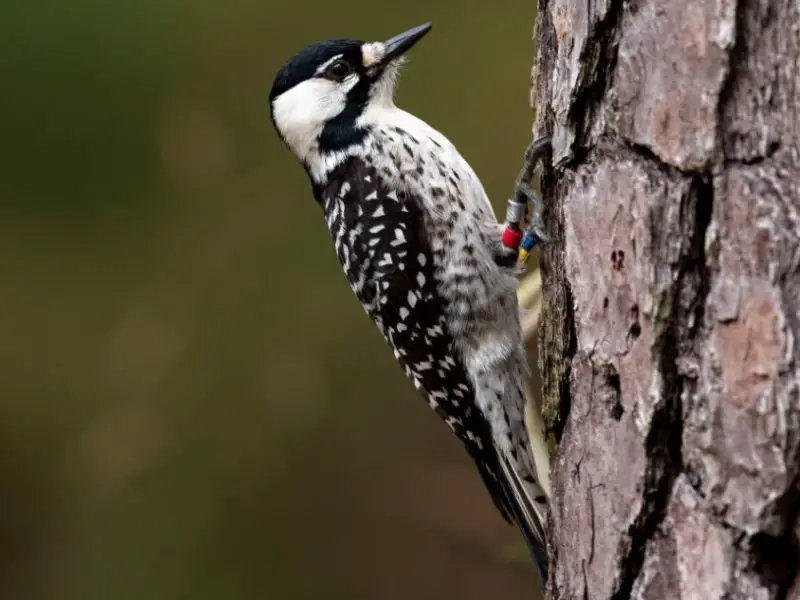
The Red-Cockaded Woodpecker (Leuconotopicus borealis) is a medium-sized woodpecker, measuring around 8.3 inches in length and weighing between 1.8 to 1.9 ounces. Its distinctive black and white coloration features horizontal stripes along its back and large white cheek patches, making it easy to recognize in its natural habitat.
This species is unique for its cooperative breeding behavior, where breeding pairs are supported by “helpers,” typically male offspring from previous breeding seasons. These helpers assist with tasks such as incubation, feeding the young, and defending the nest, which increases the breeding success of the group. The Red-Cockaded Woodpecker is one of the few bird species that demonstrate this cooperative “helpers at the nest” behavior.
This woodpecker prefers mature pine forests, and conserving these habitats is crucial not only for their survival but also for supporting other endangered species like the gopher tortoise and indigo snake. As a keystone species, the Red-Cockaded Woodpecker’s conservation benefits the broader ecosystem, making their protection essential to forest health and biodiversity.
Pileated Woodpecker
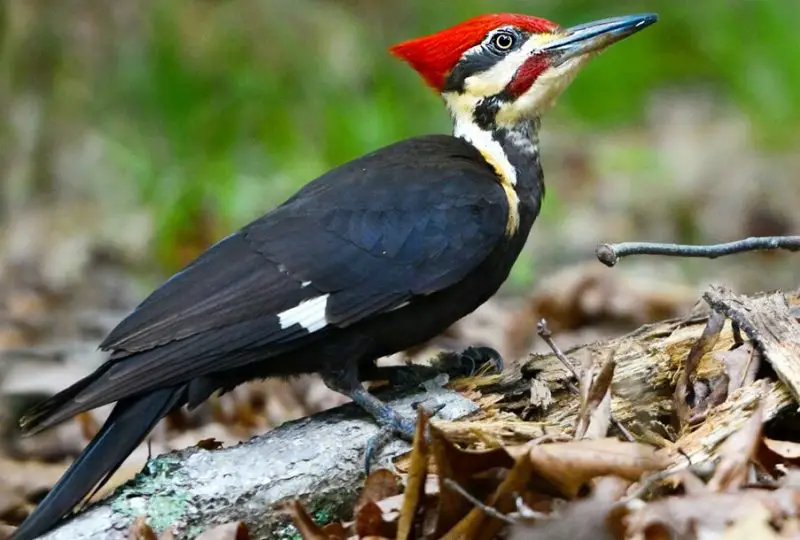
The Pileated Woodpecker (Dryocopus pileatus) is one of the largest woodpeckers in North America, measuring between 16-19 inches (40-48 cm) in length with a wingspan of 26-30 inches (66-75 cm). Its striking black and white plumage, combined with a bright red crest, makes it a distinctive presence in forests.
Adapted to their environment, Pileated Woodpeckers have specialized zygodactyl feet, featuring two toes pointing forward and two backward, which allow them to cling easily to tree trunks and branches. This adaptation is crucial for their foraging and nesting habits.
Pileated Woodpeckers primarily feed on insects, particularly carpenter ants, termites, and beetle larvae, which they skillfully extract from trees using their powerful beaks. In addition to insects, their diet also includes fruits, nuts, berries, and occasionally sap from sapsucker wells. Their large size and feeding habits often leave noticeable rectangular holes in trees, which can become shelters for other wildlife.
Northern Flicker
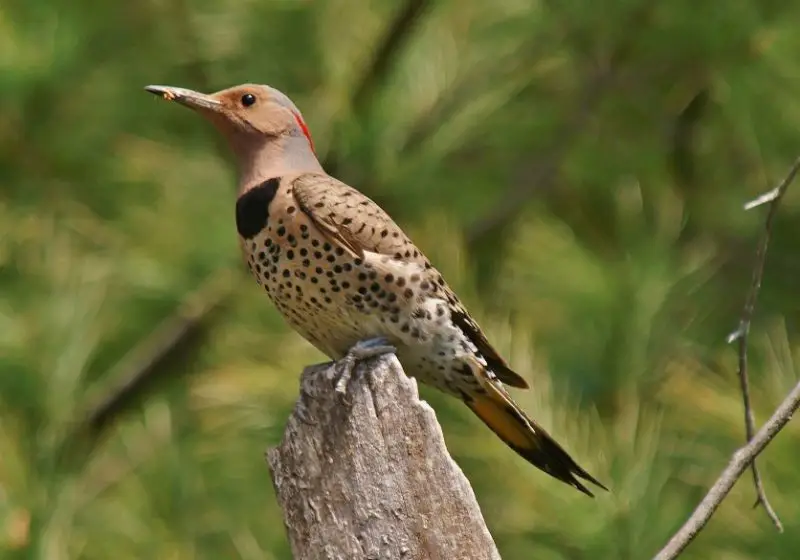
The Northern Flicker (Colaptes auratus) is a medium-sized woodpecker, measuring about 12 inches in length. It stands out due to its beautiful combination of colors, featuring a beige to grayish-brown back patterned with intricate black, crescent-shaped spots. This species also has a noticeable white rump patch, which is visible in flight, and its wings display flashes of yellow or red depending on the subspecies.
As cavity nesters, Northern Flickers excavate nest holes in dead or decaying trees, with both male and female participating in the process. The female typically lays between 5 to 8 white, oval-shaped eggs, which are incubated by both parents for 12 to 14 days until hatching.
Northern Flickers have variable migration patterns, with some staying in their breeding territory year-round while others migrate to warmer southern regions during the winter. This adaptability allows them to thrive in various habitats, from forests to urban areas. They feed on insects, especially ants, which they often find on the ground, setting them apart from other woodpeckers that primarily feed on tree-dwelling insects.
Golden Fronted Woodpecker

The Golden-Fronted Woodpecker (Melanerpes aurifrons) is a medium-sized bird known for its striking appearance and vibrant colors. Its most distinctive feature is the bright yellow patch on its forehead, giving it the “golden front.” Males have a red cap on the crown of their heads, while both sexes exhibit a white patch around the eyes and a black-and-white striped pattern on their wings and back.
This woodpecker primarily feeds on insects, larvae, fruits, and nuts. It uses its specialized bill to tap into tree trunks, locating prey hidden within the bark’s crevices. This behavior is common among woodpeckers but is notably efficient in the Golden-Fronted species.
One fascinating fact about the Golden-Fronted Woodpecker is its ability to peck with an extraordinary force of up to 1,200 g’s without suffering brain damage. This incredible resilience is due to its unique skull structure and natural shock-absorbing capabilities, allowing it to endure repeated impacts while foraging. The species is commonly found in open woodlands and urban areas throughout the southwestern U.S. and Mexico.
Ivory-Billed Woodpecker
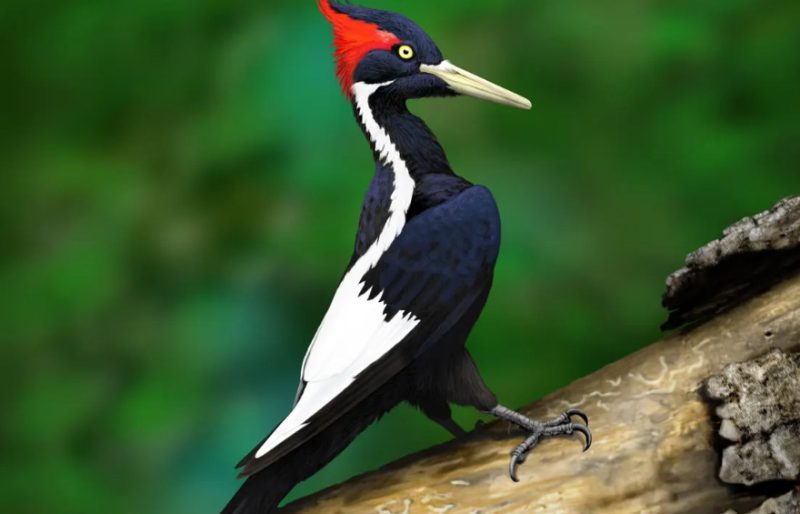
The Ivory-Billed Woodpecker (Campephilus principalis) is a remarkable and critically endangered bird known for its striking features and significant adaptations. Measuring approximately 20 inches in length with a wingspan of over 30 inches, it is one of the largest woodpeckers in the world. Its impressive size and striking appearance make it a captivating species, though its rarity adds to its allure.
Typically found in old-growth forests, the Ivory-Billed Woodpecker searches for its primary food source—beetle larvae—by pecking at dead or dying trees. Its large size and strong beak are well-suited for excavating these wood-boring insects from within the wood.
During the breeding season, both male and female Ivory-Billed Woodpeckers collaborate to build a nest. They select a dead or dying tree and create a cavity high up in the trunk, where they lay their eggs and care for their young.
However, due to habitat destruction and other factors, the Ivory-Billed Woodpecker is critically endangered, and efforts to conserve its remaining habitat are crucial for its survival. The species is elusive and may already be extinct, making sightings and conservation efforts extremely important.


